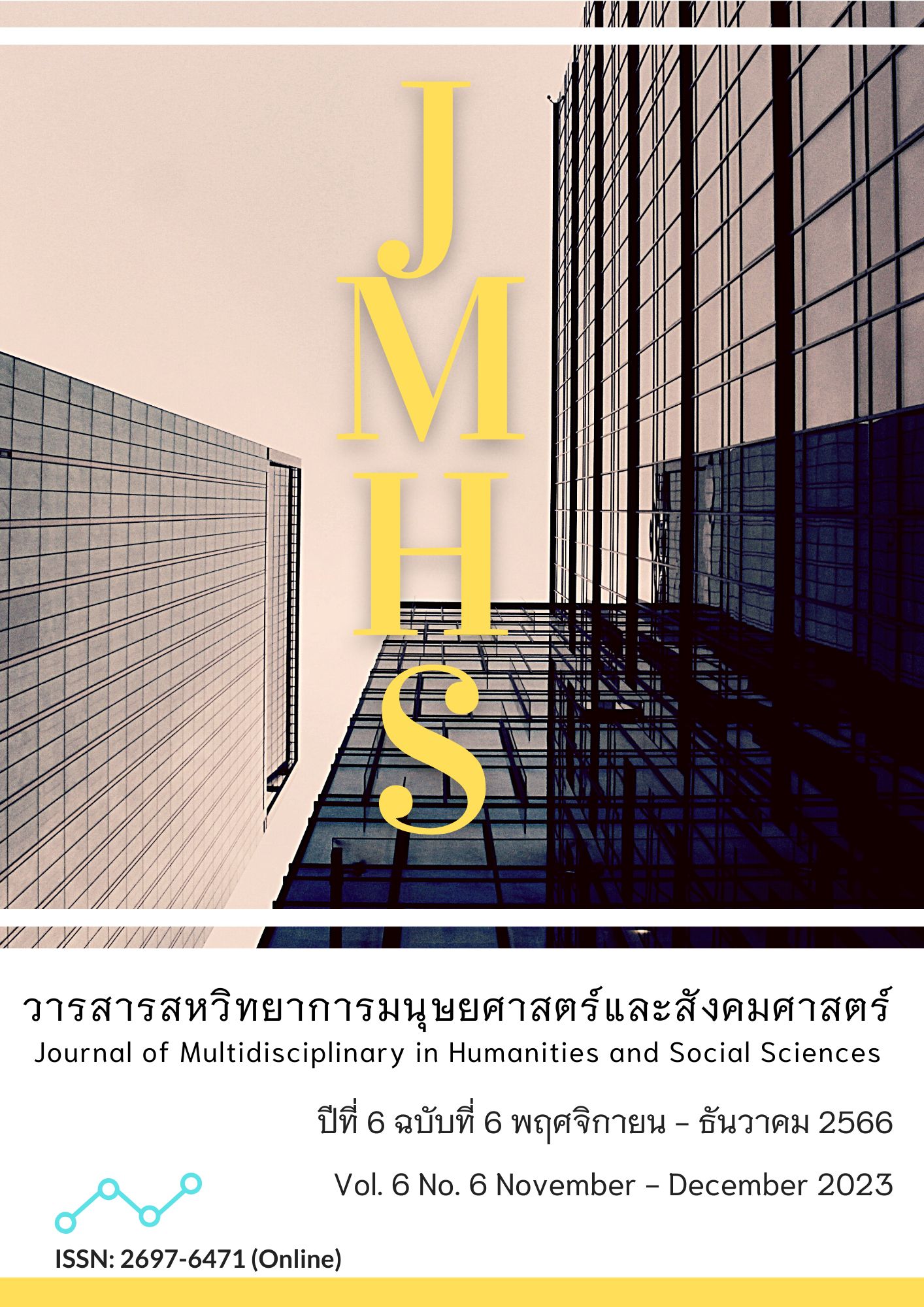Developing the Potential of Chae Son Hot Springs, Lampang Province for Health Tourism
Main Article Content
Abstract
This article aimed to: 1) study and analyze the potential of Chae Son hot spring health promotion tourist attraction, Lampang Province; 2) study the behaviors and demands of the tourists who came to travel at Chae Son hot spring health promotion tourist attraction, Lampang Province; and 3) recommend guidelines for improving the potential of Chae Son hot spring health promotion tourist attraction, Lampang Province. In order to accommodate health promotion and tourist attractions, this study was designed as mixed-methods research. The research results were found as follows:
1. The evaluation of the potential of being a health tourism destination for the types of natural hot springs in Chae Son Hot Spring, Lampang Province, showed that the quality standards overall were at an excellent level.
2. The research results showed that the influencing factors that made tourists travel to Chae Son hot spring were the tourist attractions.
3. The guidelines recommended for improving the potential of Chae Son hot spring health promotion tourist attractions in Lampang Province were as follows: 1) C: Certify tourism standard management to meet the quality standards of natural hot spring health promotion tourist attractions; 2) H: Health as the guideline in developing natural hot springs to become health promotion tourist attractions; 3) A: Attractions as the guideline in promoting tourist attractions to be increasingly well-known; 4) E: Equitability as equality of use; 5) S: Sustainable as the guideline of development by focusing on sustainable goals; 6) O: Opportunity as the guideline in developing tourist attractions in order to increase opportunity in accommodating those health tourists in the future; and 7) N: Natural as the guideline in conserving natural hot springs as well as improving the surrounding scenery.
With knowledge and findings from this research, a team of researchers has discovered the behavior of tourists who travel to Chae Son hot spring, Lampang Province, to assess their potential as a health tourism destination. They have also identified types of natural hot springs and created a model for the development of tourist attractions that can be further developed as a health tourism destination for the types of natural hot springs in other tourist attractions.
Article Details

This work is licensed under a Creative Commons Attribution-NonCommercial-NoDerivatives 4.0 International License.
Views and opinions appearing in the Journal it is the responsibility of the author of the article, and does not constitute the view and responsibility of the editorial team.
References
กรมทรัพยากรธรณี. (2566). น้ำพุร้อนแจ้ซ้อน. สืบค้นจาก https://www.dmr.go.th/น้ำพุร้อนแจ้ซ้อน/
กรมอุทยานแห่งชาติ สัตว์ป่า และพันธุ์พืช. (2566). จำนวนเงินอุทยานแห่งชาติ นักท่องเที่ยวและยานพาหนะ. สืบค้นจาก https://portal.dnp.go.th/Content/nationalpark?contentId=20014
งามนิจ แสนนําพล, วารัชต์ มัธยมบุรุษ, ประกอบศิริ ภักดีพินิจ และ พัจน์พิตตา ศรีสมพงษ์. (2563). สถานการณ์และศักยภาพของธุรกิจเชื่อมโยงการท่องเที่ยวรอบแหล่งท่องเที่ยวประเภทน้ำพุร้อน ในกลุ่มจังหวัดภาคเหนือตอนบน. วารสารสังคมศาสตร์วิชาการ 13(1), 1-17. สืบค้นจาก https://so04.tci-thaijo.org/index.php/social_crru/article/view/233506
จุไรรัตน์ ฉิมพาลี. (2563). คุณภาพการให้บริการการท่องเที่ยวเชิงสุขภาพในแหล่น้ำพุร้อนธรรมชาติ. วารสารมนุษยศาสตร์และสังคมศาสตร์ มหาวิทยาลัยราชพฤกษ์, 6(3), 1-14. สืบค้นจาก https://so03.tci-thaijo.org/index.php/rpu/article/view/248915
บำเพ็ญจิต แสงชาติ. (2540). วัฒนธรรมการดูแลตนเองในผู้ติดเชื้อเอชไอวีและผู้ป่วยเอดส์ การศึกษาในภาคตะวันออกเฉียงเหนือของประเทศไทย(วิทยานิพนธ์พยาบาลศาสตรดุษฎีบัณฑิต). มหาวิทยาลัยมหิดล.
บุญเลิศ จิตตั้งวัฒนา. (2548). อุตสาหกรรมการท่องเที่ยว. กรุงเทพฯ: เพรส แอนด์ ดีไซน์.
บุญเลิศ จิตตั้งวัฒนา. (2548). การพัฒนาและการอนุรักษ์แหล่งท่องเที่ยว. กรุงเทพฯ: เพรส แอนด์ ดีไซน์.
พิศมัย จัตุรัตน์ และ ชวลีย์ ณ ถลาง. (2565). พฤติกรรมของนักท่องเที่ยวชาวไทยที่เดินทางมาท่องเที่ยวในแหล่งท่องเที่ยวเชิงวัฒนธรรมในชุมชนของกรุงเทพมหานคร. วารสารวิทยาลัยดุสิตธานี, 16(2), 50-64. https://so01.tci-thaijo.org/index.php/journaldtc/article/view/262397
ปวารณา อัจฉริยบุตร. (2553). ธาราบำบัดและน้ำพุร้อน. วารสารมหาวิทยาลัยราชภัฏยะลา, 5(1), 87-100. สืบค้นจาก https://so04.tci-thaijo.org/index.php/yru_human/article/view/134687/100775
มนัส สุวรรณ และคณะ. (2541). การจัดการการท่องเที่ยว. (พิมพ์ครั้งที่ 8). กรุงเทพฯ: ไทยวัฒนาพานิช.
รัฐศวรรธน์ กิ่งแก้ว และ ดำรง โยธารักษ์. (2561). การพัฒนารูปแบบการจัดการการท่องเที่ยวเชิงสุขภาพของจังหวัดนครศรีธรรมราช (รายงานวิจัยสมบูรณ์). สำนักงานคณะกรรมการส่งเสริมวิทยาศาสตร์ วิจัยและนวัตกรรม.
สิรินญา แก้วแกมคำ. (2556). การศึกษาพฤติกรรมและทัศนคติการท่องเที่ยวเชิงสุขภาพของผู้สูงอายุ(สารนิพนธ์ปริญญามหาบัณฑิต). มหาวิทยาลัยมหิดล.
สุนิษา เพ็ญทรัพย์ และ ปวันรัตน์ แสงสิริโรจน์. (2555). พฤติกรรมและความพึงพอใจของนักท่องเที่ยวชาวไทยต่อการท่องเที่ยวเชิงสุขภาพ กรณีศึกษาบ่อน้ำพุร้อน รักษะวาริน อำเภอเมือง จังหวัดระนอง (รายงานผลการวิจัย). มหาวิทยาลัยยราชภัฏสวนสุนันทา.
สำนักพัฒนาแหล่งท่องเที่ยว กรมการท่องเที่ยว กระทรวงการท่องเที่ยวและกีฬา. (2559). คู่มือการประเมินมาตรฐานคุณภาพ แหล่งท่องเที่ยวเชิงสุขภาพประเภทน้ำพุร้อนธรรมชาติ. (พิมพ์ครั้งที่ 2). กรุงเทพฯ: สนามกีฬาแห่งชาติ.
สำนักอุทยานแห่งชาติ. (2566). จำนวนเงินอุทยานแห่งชาตินักท่องเที่ยวและยานพาหนะ. สืบค้นเมื่อ 14 กุมภาพันธ์ 2566, จาก https://portal.dnp.go.th/Content/nationalpark?contentId=20014
Buhalis, D. (2000). Marketing the competitive destination of the future - Growth strategies for accommodation establishments in alpine regions. Tourism Management, 21(1). DOI:10.1016/S0261-5177(99)00095-3


